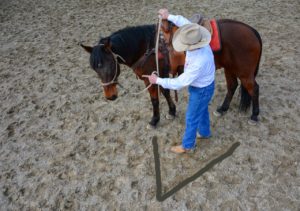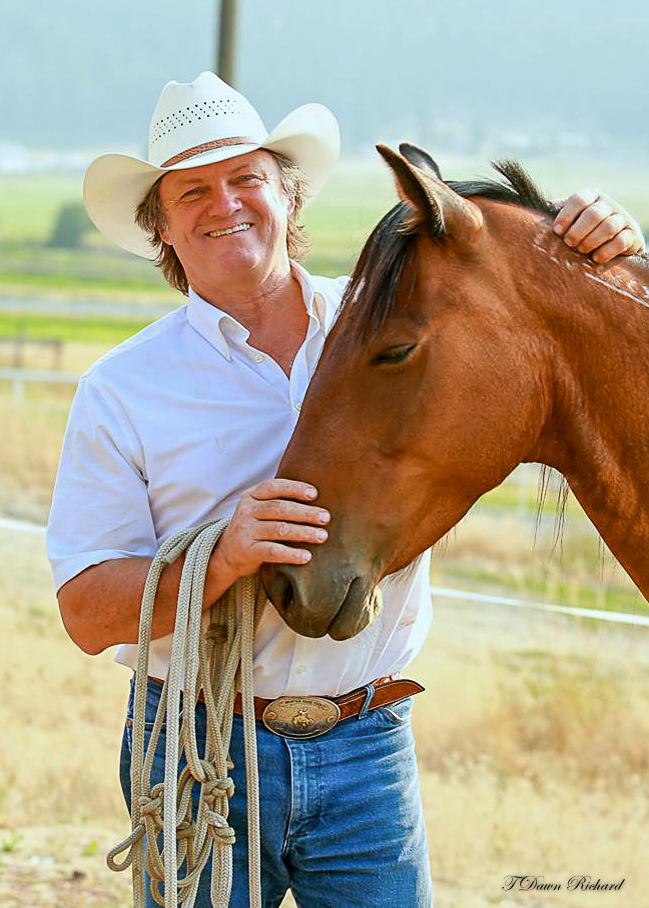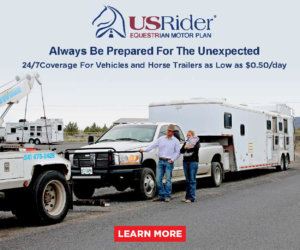Part 3: The Importance of Your Posture, Position, and Timing
by Gerry Cox

As an aspiring horseman, I try to glean any piece of information I can and implement it into my daily routine with the horses I train. I will never learn it all, but I do attempt to become a better horseman every time I walk into the pen with a horse. I listen to anyone who may have an idea that will make whatever I am doing with a horse go a little better.
Horses pay attention to humans in ways we might not realize. Having the largest eyeball of any land mammal, a horse’s perception is far more acute than ours. Horses read our body language, recognize and detect small movements, feel energy, sense mood, and so on. Something that doesn’t seem important to us can be critical to a horse.
Posture, Position and Timing
Posture: Your posture is critical to your horse whether you’re on the ground or in the saddle, This is why your horse can and will move away from you if you have a slight forward lean or assertive shape to your posture, but will stand quiet when he can detect you have relaxed your stance to more neutral posture. So be aware of your posture — it means something to your horse.
Position: The position of your body in relationship to your horse’s body is also important to your horse. He has three parts: front, center and rear, divided by his shoulder and hip joint. I think of a triangle off of his sides, dividing lines that will identify his front, center and rear sectors.
He also has a left and right half and he can detect in which of these sectors you stand or focus your energy. If you are behind his hip joint, he assumes you are communicating to his hip. If you are in front of his shoulder joint, he assumes you are communicating to his front area. In between, it’s his ribs.
But your position on your horse’s body is not the only thing to notice. There’s also the tilt of your pelvis, the position of your hands, (high, low, out to the sides, and so on), and the position of your legs when mounted (forward, back, or center; touching, not touching, tapping or pressing).
You may have heard someone say, “Look where you want your horse to go.” If you are watching his head instead of looking where you want to go, then maybe you are sending him the signal, “I’ll just go where you are looking.” The position of your head, shoulders, pelvis, legs, hands, and eyes are all critical to your horse.
Timing: We teach our horses through pressure and release of pressure. Pressure doesn’t mean pull, whip or push on your horse. Timing of the pressure and the release is critical to teach your horse to be responsive.
When introducing a cue to your horse, implement it in phases. Start with the tiniest cue first, then escalate it in a rhythmic sequence in three or four steps until you get a hint of the proper response. Don’t escalate up to five, six, or ten steps. Understand that step four might have a little tap to it!
Our goal is to simulate how his mother taught him. A mare sends a clear message by giving first the evil eye, then pinning her ears, then bunching up her neck muscles, and if all that fails, she will bite, strike or kick! That’s four phases.
If I want to train the horse to move his hip from the ground, I first ensure I am in the correct position, have neutral posture, and am aware of my timing. I then step to the point of his shoulder, then away from his body a full stride to the point of my triangle. I cock my head to focus on the hip to move sideways, then pick up and show him the tail of my lead-rope, then begin to twirl it casually and then tap his hip with it until he steps sideways, the whole time holding posture and position.
The moment I see his hip muscles engage to move sideways, I straighten up and neutralize my stance to release the cue. If he fails to move sideways, I maintain the cue (tilted head and tapping his hip) until I see him try to step sideways with his hip. I then put myself into neutral and pet him and reward him. Soon a simple cock of your eyebrow will be all it takes for your horse to understand to move his hip. Evil eye, pinned ears, or I’ll bite, strike or kick!
I sure make no claim to be an expert horseman but I’ve become aware of the critical importance of my posture, position and timing to establish better communication between human and horse.
Next month: How to Develop a Program

Gerry Cox has been riding, training and competing with horses much of his adult life and has won at endurance races, team roping, calf roping, grand champion in reining, working cow horse and trail challenges. Gerry has studied under 16 world champion horsemen. These include: Al Dunning and Les Vogt and four Road to the Horse champions—Chris Cox, Craig Cameron, Dan James and Jim Anderson.
Gerry has been a:
Top contender at the Extreme Mustang Makeover.
Top contender at Colt Start Challenge Events.
Top contender at Craig Cameron Extreme Cowboy Races.
Clinician at BLM Wild Mustang Gentling Demonstrations.
Featured Clinician on “Best of America By Horseback” (RFD-TV).
Served as judge at the National Finals Rodeo Colt Starting Championships.
1 of 10 horsemen selected to compete in the Charles Wilhelm Super Horse Challenge.
View some of Gerry’s work at www.YouTube.com (Gerry Cox Horse)
Find Gerry on FaceBook






